Two Rivals Are Battling to (Finally) Replace the Army's Bradley Fighting Vehicle
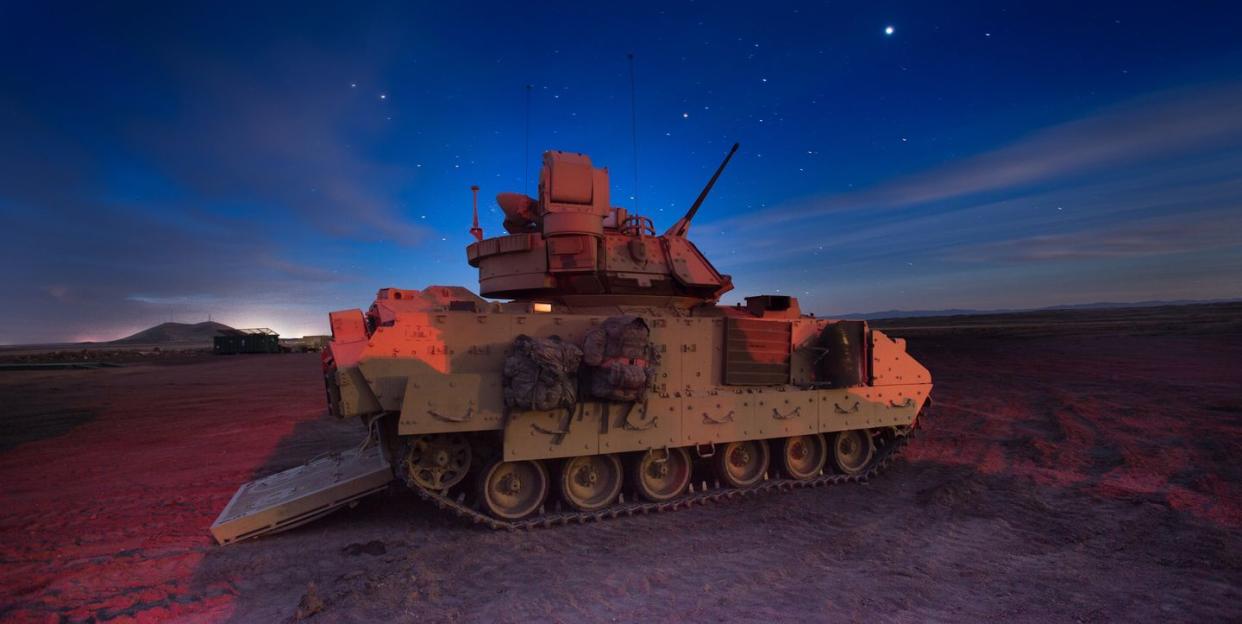
Late in June 2023, the U.S. Army announced that, of five teams tapped to submit detailed proposals for a successor to America’s thousands of 40-year-old Bradley infantry fighting vehicles, two had made the cut. The Bradley vehicles recently saw a brutal baptism of fire in Ukrainian service assaulting a Russian minefield.
This marks the fourth attempt by the Army to procure a Bradley replacement in the last 20 years. The most recent, the Optionally Manned Fighting Vehicle (OMFV), was terminated abruptly and dramatically in 2020. For the competition’s current iteration, the OMFV was eventually re-designated the XM30 Mechanized Infantry Combat Vehicle—a throwback to a 1960s-era acronym.
XM30 will boast much bigger 50-millimeter cannon, have a smaller two-person crew, use a hybrid-electric engine allowing quiet idling, and feature signature reduction and active protection systems to improve survivability.
The Pentagon plans to spend $1.6 billion more over the next three years for rival teams assembled by vehicle manufacturers General Dynamics Land Systems (GDLS) and American Rheinmetall (a subsidiary of a German company) to digitally design and, starting in 2025, physically assemble between seven and 11 prototype vehicles that will face off in trials. In 2027, the Army will choose a winner and begin procurement, with first operational units receiving deliveries in 2029. Procurement costs are expected to total $45 billion for an unspecified number of XM30s.
Ironically, the finalists are the same final two teams from the third iteration, likely drawing from the same basic designs. However, the Army’s concept has changed substantially this time around, in favor of smaller vehicle carrying fewer crew and passengers so as to control weight and still achieve a higher density of armor. There is also, seemingly, a reduced emphasis on uncrewed operations—at least in their initial configuration.
So, if this competition finally resolves, it will result in different vehicles from those on the table in 2020.
The Cursed Odyssey of the Bradley Replacement
The M2 Bradley is an infantry fighting vehicle, a class blending some of a tank’s firepower with the troop-carrying capability of an APC ‘battle taxi.’ Thus, the Bradley carries infantry to battle while also acting as a bruiser—armed with long-distance TOW anti-tank missiles and a rapid-firing Bushmaster 25-millimeter chain cannon that is lethal against personnel and lighter armored vehicles.
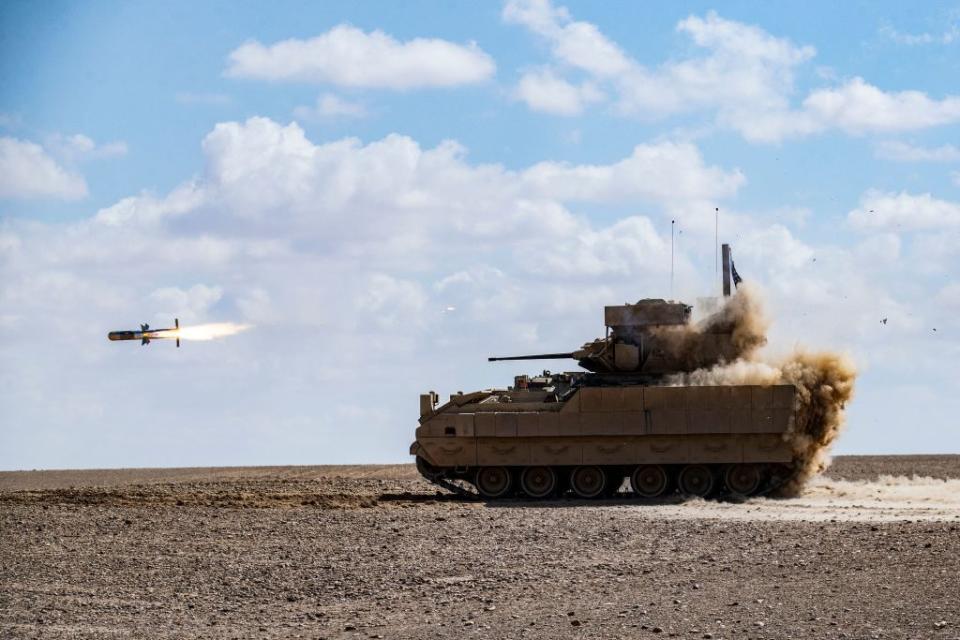
The M2 Bradley’s current 30 tons of weight—twice that of its Soviet equivalent, the BMP-2—reflects more robust armor against heavy machine guns, artillery shrapnel, and autocannons.
While the Bradley was highly successful in the 1991 Gulf War, the post-Cold War Pentagon thought that intense armored battles were a thing of the past and wanted a much lighter family of vehicles—known as the Future Combat System—that would rely on networked communications and sensors to avoid losses.
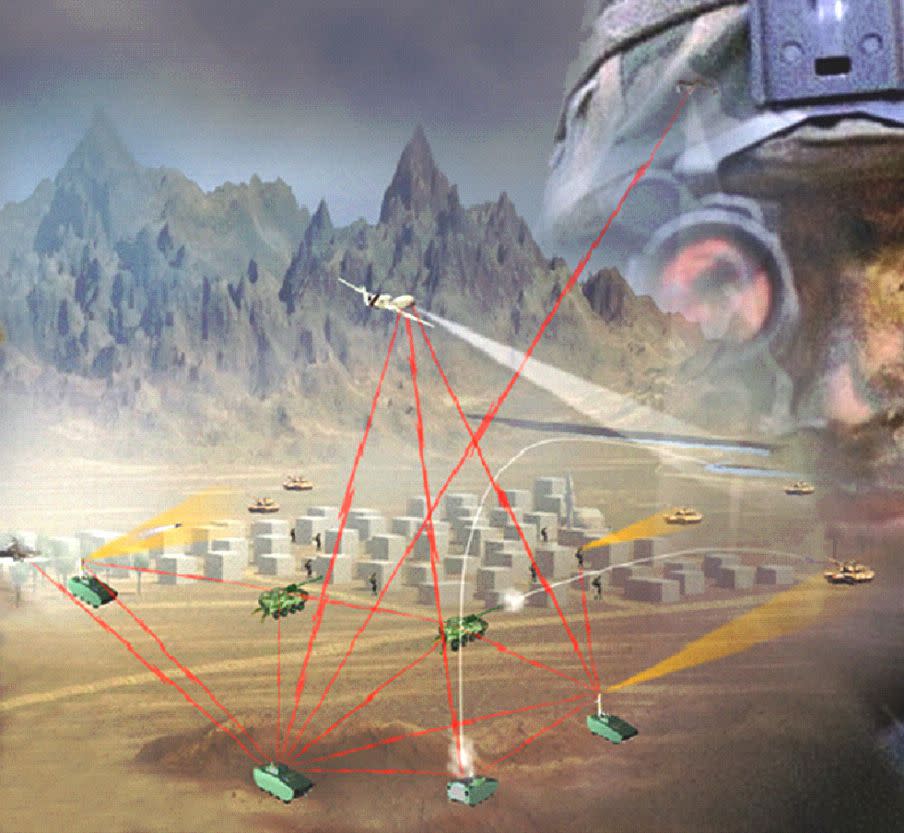
The over-ambitious FCS program was canceled 2009 after consuming $18 billion. By then, combat experience in Iraq had convinced the Army that heavy armor was actually still very useful for keeping soldiers alive. The second Bradley replacement—the Ground Combat Vehicle—swung the pendulum far the other way, seeking protection margins that made it impractically overweight and leading to its cancellation in 2014.
The third attempt, the NGCV or OMFV competition, was meant to be more balanced. But the Army demanded an extremely rapid development timeline with inflexible requirements, scaring away industry interest. In the end, the Army turned its nose up at the two finalists, General Dynamics’ Griffin III and Rheinmetall’s KF41 Lynx, disqualifying the latter due to delays securing a transportation permit to deliver the prototype for evaluation and rejecting the former because it was too large and heavy.
The competition was re-launched the same year with the intention of inviting a more flexible and unhurried approach to industry. In 2021, five teams—Rheinmetall, GDLS, Oshkosh and South Korea’s Hanwha, BAE Systems, and Point Blank Enterprise (most well known for body armor)—were awarded $300 million to develop proposals. Oshkosh and Hanwha collaborated on a concept evolved from the latter’s K-21 IFV, and BAE Systems offered an evolution of the Bradley-based AMPV tracked utility vehicle.
Bringing out the Big Guns
The XM30 will retain tracks for all-terrain mobility, and come out heavier than the Bradley for increased protection. However, its weight and dimensions must still allow two to be transported in a single C-17 cargo jet. Towards that end, the Army settled on a design carrying just six soldiers into combat, with a crew downsized from three to two thanks to automation: a commander/driver and a gunner for the vehicle’s remote-control turret.
Currently, U.S. mechanized platoons constitute three squads of nine infantry awkwardly spread out between four Bradley vehicles with a capacity of seven infantry each. Popular Mechanics asked Nicholas Drummond, a British expert on armored vehicles who serves as an advisor to armored vehicle conglomerate KNDS (not in the competition), if the 6-person squads risked being too small. Drummond stressed that his comments for the article were on an independent basis.
“I’m expecting platoons with 6 OMFVs,” he replied. “Operating in pairs they will deliver three dismounted squads of 12 soldiers.” He added that the C-17 requirement “suggests a maximum combat weight of 42.4 tons.”
The XM30 will debut with the capability to drive autonomously between waypoints on a map, but uncrewed combat capability will come later—if ever. The vehicles software, intended to network seamlessly with friendly sources, will begin development separately from the vehicle itself in 2024-2025.
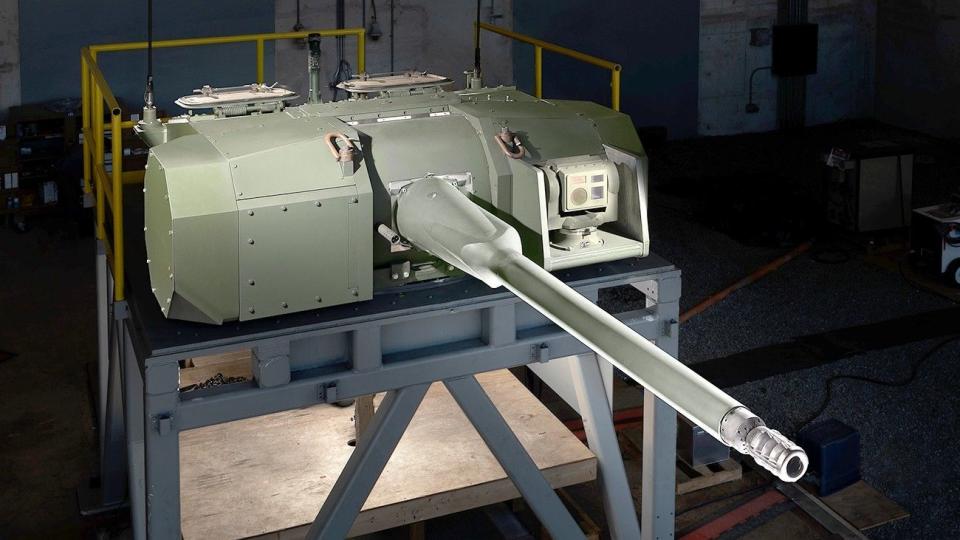
The XM30’s primary weapon will be a 50-millimeter (2’’) caliber XM913 chain gun autoloading linkless shells with a firing rate of 200 rounds per minute. That’s twice the caliber of the Bradley’s 25-millimeter gun, but each round is many the times weight and volume.
The XM913 has an effective range against armored targets up to 2.5 miles away, and softer ones up to 4.3 miles, with each shot hitting much harder. In addition to the XM1203 armor-piercing sabot rounds, against infantry, the gun can use XM1204 exploding rounds that can be programmed to either burst in the air to swat drones and threaten infantry in trenches, or to explode after penetrating the wall of a structure.
Like the Bradley, the XM30 will also retain a machine gun and a missile-launcher for tackling heavy tanks and possibly low-flying helicopters at long range.
The Strong, Silent Type
Another landmark change for the XM30 involves using a hybrid-electric motor that will allow XM30s to efficiently idle without the growl and fuel expenditure of running its diesel engine all the time and, presumably, support more electricity-hungry systems.
While Pentagon emission reduction targets may influence demand for hybrid propulsion, they also have potential operational benefits in fuel logistics and acoustic stealth. That fits in with the Army’s broader emphasis on ‘signature reduction’ for XM30, which likely implies the use of coatings, armor materials, heat venting pipes or camouflage systems to reduce or distort the XM30’s thermal/infrared signature. Such measures employed on Russian tanks have proven effective in combat, according to Ukrainian reports. The Army might also look for means to reduce radar and electromagnetic signatures.
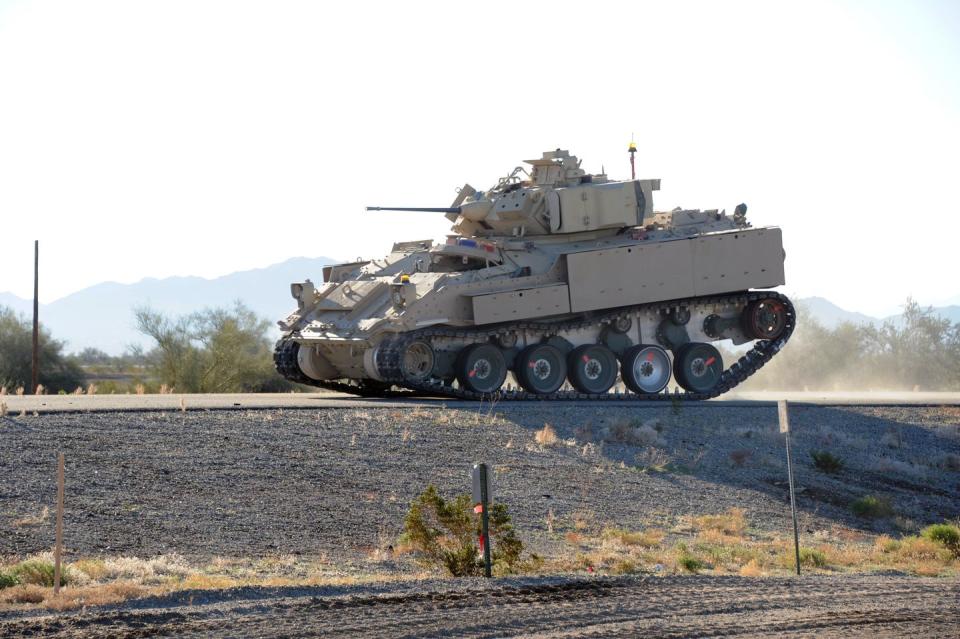
For protection after detection, the XM30 may integrate an Active Protection System that detects incoming projectiles by radar and automatically shoots them down before they can penetrate the tank. It may also discharge multi-spectral smoke grenades to obscure the vehicle from anti-tank operators and laser targeters.
Drummond also expects “…appliqué armour to be added delivering main battle tank levels of protection.” In other words, the XM30 could be fitted in the field with additional heavy armor plating or explosive-reactive armor bricks to improve survival in high-risk environments without being weighed down during training, transit, or low-intensity operations.
The XM30 may also have an aperture to store, launch, and recharge small drones, which have proven extremely useful in aiding armor commanders in Ukraine by spotting enemies concealed behind cover.
Looking further ahead, the Army wants XM30 to support modular mission packages and retain room to install additional systems over 4-5 decades of service. As for the preceding M113 and Bradley, an ‘ecosystem’ of specialized variants based on the XM30 will likely develop that could include recon, anti-tank, air defense, engineering, armored recovery, medical evacuation, and command-and-control models.
The XM30 is also intended for export, increasing the user base and thereby improving economies of scale. Additionally, the Army is looking into use of AI-assisted predictive maintenance technology to reduce operating costs.
The Griffin Vs. the Lynx, Round 2
Given that so many fundamental characteristics of what the Army is looking for in the XM30 are now locked in, how will the prototype designs from Rheinmetall America and General Dynamics differ?
The best clues we have come from the vehicles that these will be evolved from.
Drummond asserted that “the GDLS [vehicle] is based on the same chassis as the M10 Booker MPF / light tank/assault gun. Rheinmetall’s offering is based on KF41 Lynx. Both have 800 hp MTU engines mated to an electric hybrid drive system, and Horstman in-arm hydro-pneumatic suspensions.”
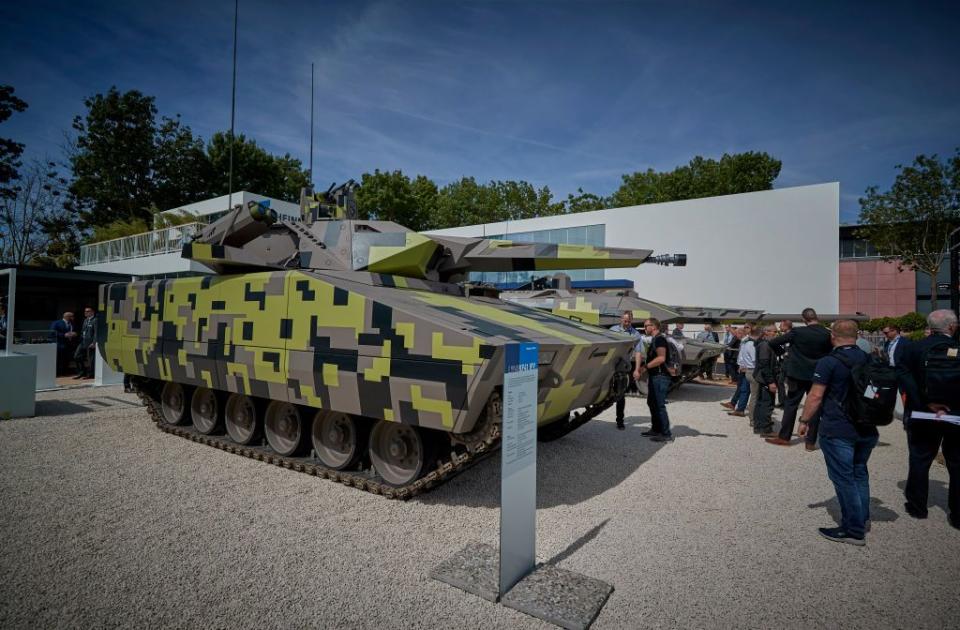
The space-agey KF41 was originally armed with a 30mm gun and ablea to transport eight or nine soldiers—more than the Army wants the XM30 to be able to carry. “Lynx is a whopping great vehicle so it’ll be interesting to see whether it has shrunk,” Drummoned observed.
Currently, 218 KF41s at a cost of $2.4 billion are being delivered to Hungary, with Australia and Greece likely to buy hundreds more. Iraq, Romania and Ukraine are potential future clients as well. Equipment used in base-model KF41s includes Raytheon’s Quick Kill Active Protection System, TOW or Israeli Spike anti-tank guided missiles, and the Raytheon Coyote drone.
The Lynx is configured for customizable modular armor that can be upscaled and tweaked depending on the threat environment. It’s supposedly optimized for cost-efficiency and low technical risks by relying on mature off-the-shelf technologies. Lynx contracts seemingly imply a unit price of $9-11 million each. That’s not that cheap, except when compared to Germany’s pricier Puma fighting vehicles, though such contracts usually lump in additional services and bits of equipment.
American Rheinmetall’s team has lined up prominent U.S. subcontractors supporting the team including Anduril, Allison, Textron, RTX, and L3 Harris.
GDLS has kept the appearance and even the name of their concept tank close to the vest, but most expect that it will be descended from the Griffin III demonstrator IFV unveiled in 2018.
The Griffin III demonstrator was derived from the Austrian-Spanish ASCOD armored vehicle family. Variously named versions are in service in Spain (Pizarro), Austria (Ulan), the United Kingdom (Ajax) and, most significantly, the U.S.—in the form of the Army’s new M10 Booker light tank/assault gun.
While the Griffin III demonstrator sported a distinctive tiled camouflage system, later concept art associated with an electronic architecture system called Katalyst implies a different approach. The Griffin III was built from the onset to use the 50-millimeter gun in a turret that could elevate up to 85 degrees, enhancing utility against drones or battle amidst urban hi-rises.
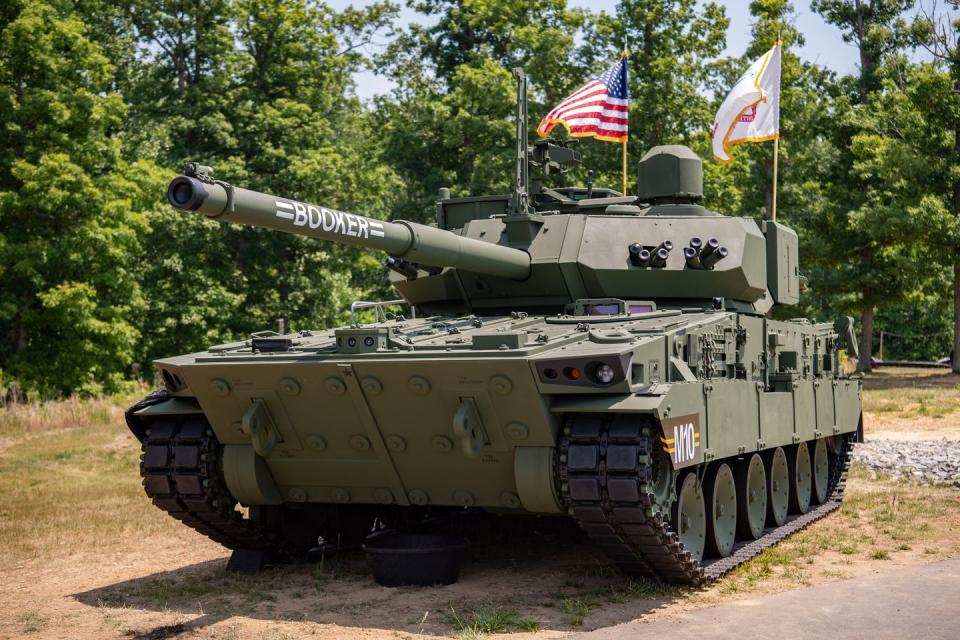
“They have now moved beyond these [earlier demonstrators] but you can see the ASCOD/Booker/Ajax origins in each,” Drummond wrote. “I have been very impressed by the way in which the MPF team worked with GDLS to develop Booker. This is a very swept-up project that has turned out well. The same US Army personnel will manage OMFV. I have confidence that OMFV will deliver a great capability and redefine the category. We might even see M30 OMFVs working closely with M10 Bookers in expeditionary units.”
It’s worth reemphasizing that any base designs will be heavily reworked to meet the fairly specific Army requirement in the digital design phase. Only then may we may get a better sense of how GDLS’s and Rheinetmall’s final submitted designs compare. And, in 2027, somewhere between 14 and 22 of these vehicles will hit the road and mud to determine which gets to inherit the mantle of the Bradley’s considerable role in the Army’s force structure.
You Might Also Like

 Yahoo Movies
Yahoo Movies 
